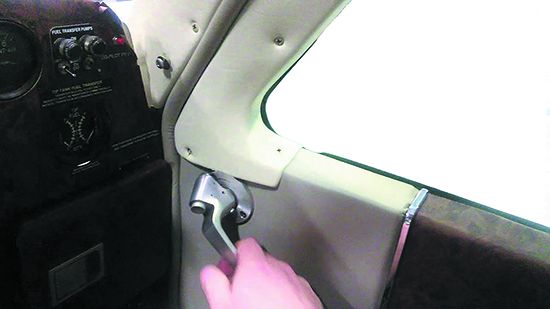The day’s mission was a 1450-mile round trip to retrieve a friend’s son for a holiday visit. My V35 Bonanza had been fueled the night before for an early departure, and the two passengers arrived on schedule. After passenger briefings and an explanation of how to open and close the cabin door, among other items, we launched.
As we accelerated in initial climb, it became obvious the door wasn’t correctly latched. The departure airport was a bit tight for me under that circumstance, so we slowed down and cruised to a nearby facility with longer runways. Along the way, I cautioned my right-seat passenger to not lean on the door—don’t even touch it until we were back on the ground, in fact—and we made an uneventful landing.
Only after taxiing to the non- towered divert airport’s ramp and shutting down the engine did we mess with the door, opening it fully and securely closing it. I tested it by pushing on the upper and lower latch areas, without any sign of it not being fully closed. After restarting and performing a full pre-takeoff checklist and run-up, we took off again, landing at the destination without any further issues. The trip back home later that day also was uneventful and everyone enjoyed the airplane ride, including the friend’s son, who had never been in a light airplane before.
How the door became unlatched, or was never latched for the first takeoff, still isn’t clear to me. I performed my normal push-outward checks before the first takeoff that day, but somehow missed that the door wasn’t fully latched.
Like many Bonanza pilots, I’ve trained for an open door and flown the airplane to a normal landing with it open. The handling is a non-issue, but the noise, anxiety and confusion argue in favor of a slow, methodical approach to getting the airplane on the ground and the door secured. Over the years, I’ve had many doors and windows open, and the first solution always is to fly the airplane.
Have you encountered a situation or hazardous condition that yielded lessons on how to better manage the risks involved in flying? Do you have an experience to share with Aviation Safety’s readers about an occasion that taught you something significant about ways to conduct safer flight operations? If so, we want to hear about it.
We encourage you to submit a brief (500 words) write-up of your Learning Experience to Aviation Safety for possible publication. Each month, Aviation Safety publishes a collection of similar experiences sent to us by readers. Sharing with others the benefit of your experience and the lessons you learned can be an invaluable aid to other pilots.
You can send your account directly to the editor by e-mailing it to [email protected]. Put “Learning Experience Submission” in the subject line; add your name and daytime telephone number at the bottom of the e-mail.
Your report will be considered for publication in the Aviation Safety’s readers’ forum, “Learning Experiences,” and may be edited for style and length. Anonymity is guaranteed if you want it. No one but Aviation Safety’s editor is permitted access to the reports. Your name and telephone number are requested only so that the editor can contact you, if necessary.
While we can’t guarantee your submission will get published, we can guarantee that we’ll closely review and consider using it.
All Learning Experiences submissions become the property of Aviation Safety and may be republished.




